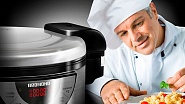5 Ways to Cook an Egg

The egg is a wonder food. There are few single ingredients that can contribute so much flavour and texture to a variety of dishes also be cooked in so many ways on their own. High in protein, eggs are considered one of the best ways to start your day.
Here is our list of just five of the hundreds of ways that you can cook your egg.
1. Hard-boiled eggs
Probably the easiest and most hassle-free, can’t-get-it-wrong ways to cook an egg, this is the quick breakfast preparation of choice for uni students and single men everywhere.
All you have to do is bring a pot of water to boil, then place your eggs into it so that they are completely immersed. The entire process takes between 10 and 12 minutes.
This cooks the egg white and yolk right through, giving them a firm texture, hence the 'hard’ in hard-boiled.
2. Soft-boiled eggs
This is the underdone cousin of the hard-boiled egg. The only difference in preparation is that you cut the cooking time by roughly half to 5 to 6 minutes. Although quicker, you have to watch soft-boiled eggs closely as they can easily get overdone if you leave them in hot water too long.
The perfectly-done soft-boiled egg has the egg white done to firmness while the yolk is still runny. It makes for a great combination of textures.
3. Scrambled eggs
This is another easy way of cooking eggs which can be adapted to your particular tastes.
The first step to scrambled eggs is to break and mix them in a bowl; you can add milk if you want to give it a softer texture.
Cook the mixture at a medium-high temperature in butter, pushing the eggs to the centre to keep it cooking well. It usually takes about a minute but depends on the consistency at which you prefer your scrambled eggs to be. Add cheese, herbs and spices to taste.
4. The Omelette
The omelette is unique in that it is prepared so the ingredients keep cooking after you remove the preparation from the heat.
Firstly, mix two eggs, a tablespoon of water and salt and pepper to taste in a bowl and whisk well. Melt some butter in a 20-cm skillet on medium-high heat until the butter is sizzling.
Pour the egg mixture into the skillet and move the skillet until it covers the base. The base will start to set within two minutes while the top remains viscous.
Slide the omelette onto a serving plate and place ham, cheese, tomato and greens of your choice, garnished with coriander onto half the surface. Fold the other half over and the heat will continue to cook the fillings.
5. Fried Eggs
Fried eggs can be prepared in three different ways:
- over easy;
- over medium;
- over hard.
The difference between the three is the consistency of the yolk.
All three methods need for you to break an egg carefully into a pan where you have melted butter over medium-high heat. Turn down to low heat as soon as the egg is added.
Cook one side until the surface of the yolk has semi-solidified, then flip over. Over easy eggs are done as soon as a solid layer forms over the yolk (the inside is still runny).
For over medium and over hard eggs, you will cook slightly longer, until the yolk has solidified slightly in case of over medium and completely solidified with over hard eggs.
Read also:
-
 2 March 2017 5 Reasons Why You Should Buy a Yogurt Maker
2 March 2017 5 Reasons Why You Should Buy a Yogurt Maker -
 20 March 2017 Best Vegetarian Recipes for Your Multi Cooker
20 March 2017 Best Vegetarian Recipes for Your Multi Cooker -
 13 July 2017 How to Develop and Write a Recipe
13 July 2017 How to Develop and Write a Recipe
You found 120 egg(s) and 23 rabbit(s). Your discount — 20%!











